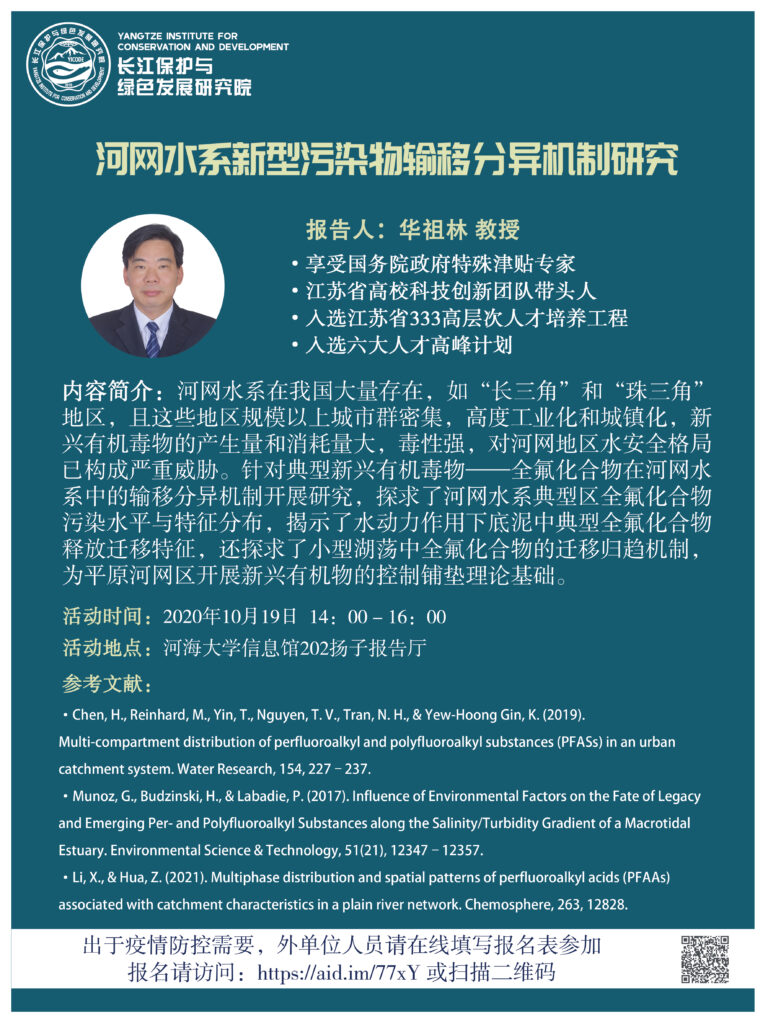本期學(xué)術(shù)交流活動(dòng)由水生態(tài)與環(huán)境研究中心牽頭舉辦,,我們很榮幸邀請(qǐng)到中心主任陳求穩(wěn)教授、華祖林教授作相關(guān)學(xué)術(shù)報(bào)告,,共同探討水生態(tài)與環(huán)境方向的熱點(diǎn)及前沿問題,。
陳求穩(wěn):太湖水生態(tài)風(fēng)險(xiǎn)管控策略的不同見解探討
內(nèi)容簡(jiǎn)介

分析了太湖近15年?duì)I養(yǎng)鹽和藍(lán)藻水華的變化趨勢(shì)及存在的問題,提出在當(dāng)前情況下提質(zhì)控藻目標(biāo)的可達(dá)性較低,,建議調(diào)整當(dāng)前的治理和管理思路,,應(yīng)以兩個(gè)確保為核心,加強(qiáng)水華監(jiān)控和風(fēng)險(xiǎn)管控,;長(zhǎng)遠(yuǎn)治理而言,,在氣候變化背景下,水華可能持續(xù)加劇,,需要執(zhí)行更低的營(yíng)養(yǎng)鹽尤其磷閾值標(biāo)準(zhǔn),;未雨綢繆,加強(qiáng)藻毒素和抗生素等新型污染物生態(tài)風(fēng)險(xiǎn)防控研究,,提升太湖飲用水源地安全,。
推薦提前閱讀的文獻(xiàn)資料
- Ho, J. C., Michalak, A. M., & Pahlevan, N. (2019). Widespread global increase in intense lake phytoplankton blooms since the 1980s. Nature, 574(7780), 667–670. https://doi.org/10.1038/s41586-019-1648-7
- Woolway, R. I., Kraemer, B. M., Lenters, J. D., Merchant, C. J., O’Reilly, C. M., & Sharma, S. (2020). Global lake responses to climate change. Nature Reviews Earth & Environment. https://doi.org/10.1038/s43017-020-0067-5
- Huisman, J., Codd, G. A., Paerl, H. W., Ibelings, B. W., Verspagen, J. M. H., & Visser, P. M. (2018). Cyanobacterial blooms. Nature Reviews. Microbiology, 16(8), 471–483. https://doi.org/10.1038/s41579-018-0040-1
華祖林:河網(wǎng)水系新型污染物輸移分異機(jī)制研究
內(nèi)容簡(jiǎn)介

河網(wǎng)水系在我國大量存在,如“長(zhǎng)三角”和“珠三角”地區(qū),且這些地區(qū)規(guī)模以上城市群密集,,高度工業(yè)化和城鎮(zhèn)化,,新興有機(jī)毒物的產(chǎn)生量和消耗量大,毒性強(qiáng),,對(duì)河網(wǎng)地區(qū)水安全格局已構(gòu)成嚴(yán)重威脅,。針對(duì)典型新興有機(jī)毒物——全氟化合物在河網(wǎng)水系中的輸移分異機(jī)制開展研究,探求了河網(wǎng)水系典型區(qū)全氟化合物污染水平與特征分布,,揭示了水動(dòng)力作用下底泥中典型全氟化合物釋放遷移特征,,還探求了小型湖蕩中全氟化合物的遷移歸趨機(jī)制,為平原河網(wǎng)區(qū)開展新興有機(jī)物的控制鋪墊理論基礎(chǔ),。
推薦提前閱讀的文獻(xiàn)資料
- Chen, H., Reinhard, M., Yin, T., Nguyen, T. V., Tran, N. H., & Yew-Hoong Gin, K. (2019). Multi-compartment distribution of perfluoroalkyl and polyfluoroalkyl substances (PFASs) in an urban catchment system. Water Research, 154, 227–237. https://doi.org/10.1016/j.watres.2019.02.009
- Munoz, G., Budzinski, H., & Labadie, P. (2017). Influence of Environmental Factors on the Fate of Legacy and Emerging Per- and Polyfluoroalkyl Substances along the Salinity/Turbidity Gradient of a Macrotidal Estuary. Environmental Science & Technology, 51(21), 12347–12357. https://doi.org/10.1021/acs.est.7b03626
- Li, X., & Hua, Z. (2021). Multiphase distribution and spatial patterns of perfluoroalkyl acids (PFAAs) associated with catchment characteristics in a plain river network. Chemosphere, 263, 128284. https://doi.org/10.1016/j.chemosphere.2020.128284
預(yù)約報(bào)名
交流活動(dòng)歡迎校內(nèi)外所有師生參加,。出于疫情防控的需要,外單位人員請(qǐng)?jiān)诰€填寫報(bào)名表,。
您提交此表單時(shí),,我們將認(rèn)為您已經(jīng)完全理解我們的《隱私策略》并授權(quán)我們據(jù)此處理您提供的可識(shí)別個(gè)人身份信息。
聯(lián)系人:郁老師
聯(lián)系電話:025-83772079
郵箱:zihan.yu@yicode.org.cn
]]>
